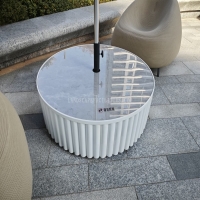Welcome to the website for landscape facilities products and knowledge.
How does the table’s design accommodate the need for quick and easy relocation within a workspace?
In today's dynamic work environments, the ability to quickly rearrange workspace layouts has become increasingly valuable. Modern table designs incorporate several innovative features that address this need for mobility and flexibility, transforming static furniture into adaptable solutions for contemporary offices and shared workspaces.
The foundation of portable table design begins with material selection. Manufacturers increasingly utilize lightweight yet durable materials like aluminum composites, reinforced plastics, and engineered woods that significantly reduce overall weight without compromising structural integrity. This fundamental characteristic makes tables substantially easier to lift and carry when relocation becomes necessary.
Perhaps the most recognizable feature in mobile-optimized tables is the integration of wheel systems. High-quality casters with locking mechanisms allow effortless rolling across various floor surfaces while providing stability during use. Advanced caster designs incorporate soft-rubber tires that protect flooring and minimize noise during movement, alongside swivel capabilities that enable precise positioning in tight spaces.
Folding mechanisms represent another critical innovation in portable table design. Strategic hinge placements and collapsible leg systems allow tables to transform into compact, flat-packed forms that require minimal storage space. This feature proves particularly valuable in multi-purpose environments where the same area must serve different functions throughout the day, such as conference rooms that convert to open collaborative spaces.
Beyond physical mobility, many modern tables incorporate modular connection systems that enable rapid reconfiguration of entire workstations. These interlocking mechanisms allow individual tables to connect securely, forming larger continuous surfaces when needed, then separate just as easily for independent use in different locations.
Ergonomic considerations extend to the relocation process itself. Designers incorporate balanced weight distribution and strategically placed handles that make carrying more comfortable and reduce strain on users. Some models feature innovative "tip-and-roll" systems where tables tilt onto two wheels for single-person transportation similar to maneuvering luggage.
The growing emphasis on workspace flexibility has driven manufacturers to develop comprehensive solutions that address both mobility and functionality. These design innovations collectively transform tables from permanent fixtures into dynamic elements that can adapt to changing work requirements, collaborative projects, and space optimization needs throughout the workday without requiring specialized tools or excessive physical effort.
As work environments continue evolving toward more agile and collaborative models, table designs that prioritize easy relocation will remain essential components of productive spaces. The integration of thoughtful mobility features represents a significant advancement in office furniture, acknowledging that how easily we can move our work surfaces directly impacts how effectively we can utilize our workspaces.
Related search:

Recommendation
Round metal tube border design table with tempered glass or granite countertop on the top.